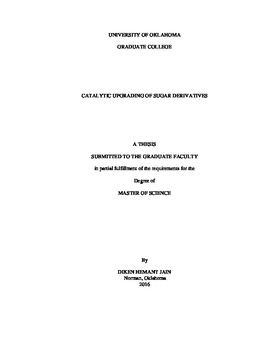| dc.description.abstract | With industrial revolution there has been a huge increase in demand for petroleum-based fuel. Detrimental effects on environment due to unprecedented use of fossil fuels and shortage in its availability has spurred the search for renewable and low carbon emission fuels. Solution is provided in the form of lignocellulosic biomass. It has helped in reducing human dependence on fossil fuels, it is carbon neutral and it is a continuous source of energy. However, lignocellulosic biomass cannot be used in its present form. Need is to convert the biomass into fuel that is convenient to use, robust and efficient. Thermochemical conversion technology has shown promising results in conversion of lignocellulosic biomass to bio-oil. Multistage pyrolysis is one of the thermochemical processes giving high yield of bio-oil. Analyzing all the fractions of multistage pyrolysis process it is found that the yield of levoglucosan was highest as compared to all the other compounds. Hence, there is a need to convert levoglucosan to a valuable compound.
In this present contribution, upgrading strategy of levoglucosan is investigated. Shortcoming of upgrading a sugar derivative and measures taken to overcome them have been discussed. Efforts to find compounds which can either directly act as fuel or as intermediates in production of fuels, have been carried out. Various catalyst systems have been tested for this purpose. 5 wt.% Pd/MWCNT was able to convert glucose to cyclic ketones in a single pot reaction. Cyclic ketones can undergo aldol condensation to form diesel range products. An attempt has been made to optimize the reaction conditions to get highest yield of products.
We can also derive numerous chemical building blocks from biomass. These building blocks either supplement or replace current supply of petroleum-derived chemicals. In the later part, we discuss the upgrading strategy of furfural to 1,5-pentanediol, which finds application as polyester and plasticizer. Furfural is hydrogenated on bimetallic catalyst like Cu/Ni to tetrahydrofurfuryl alcohol (THFAL). THFAL is converted to 1,5-pentanediol by direct hydrogenolysis or by a multi-step process. We intend to develop a bifunctional catalyst which is able to carry out multi-step process in a single pot reaction. We investigate different catalyst systems and solvents, to get high yield of 1,5-pentanediol. Cu/SiO2-Al2O3 was able to convert 3,4 dihydropyran to 1,5 pentanediol with a yield of 80% in 3 hrs. Using tetrahydrofurfuryl alcohol as feed and MCM-41-SO3H-PTS as catalyst a combined product yield (3,4 dihydropyran and δ-hydroxyvaleraldehyde) of 21% is attained in 2 hrs. | en_US |
